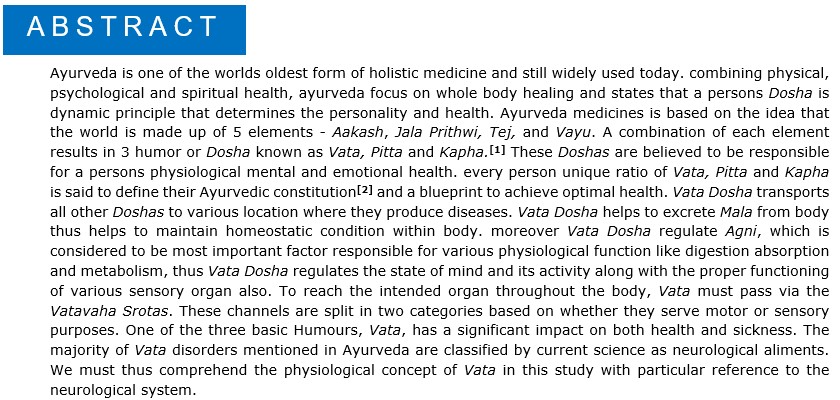Physiological concept of Vata Dosha in relation to Brain Function
DOI:
https://doi.org/10.21760/jaims.9.5.27Keywords:
Vata Dosha, Manas, Prana Vata, Udana Vata, Samana Vata, Vyana Vata, Apana VataAbstract
Ayurveda is one of the worlds oldest form of holistic medicine and still widely used today. combining physical, psychological and spiritual health, ayurveda focus on whole body healing and states that a persons Dosha is dynamic principle that determines the personality and health. Ayurveda medicines is based on the idea that the world is made up of 5 elements - Aakash, Jala Prithwi, Tej, and Vayu. A combination of each element results in 3 humor or Dosha known as Vata, Pitta and Kapha.[1] These Doshas are believed to be responsible for a persons physiological mental and emotional health. every person unique ratio of Vata, Pitta and Kapha is said to define their Ayurvedic constitution[2] and a blueprint to achieve optimal health. Vata Dosha transports all other Doshas to various location where they produce diseases. Vata Dosha helps to excrete Mala from body thus helps to maintain homeostatic condition within body. moreover Vata Dosha regulate Agni, which is considered to be most important factor responsible for various physiological function like digestion absorption and metabolism, thus Vata Dosha regulates the state of mind and its activity along with the proper functioning of various sensory organ also. To reach the intended organ throughout the body, Vata must pass via the Vatavaha Srotas. These channels are split in two categories based on whether they serve motor or sensory purposes. One of the three basic Humours, Vata, has a significant impact on both health and sickness. The majority of Vata disorders mentioned in Ayurveda are classified by current science as neurological aliments. We must thus comprehend the physiological concept of Vata in this study with particular reference to the neurological system.
Downloads
References
Sengupta Narendranath, Sengupta Balaichandra, editors. Caraka Samhita of Agnivesa. Janakpuri. 1st ed. Rashtriya Sanskrit Sansthan; 2002. Narendranath Sengupta & Balaichandra Sengupta, editors, (1st ed.). Sutrasthan. Caraka Samhita of Agnivesa. Janakpuri: Rashtriya Sanskrit Sansthan, 2002.p.202
Sengupta Narendranath, Sengupta Balaichandra, editors. Caraka Samhita of Agnivesa. Janakpuri. 1st ed. Rashtriya Sanskrit Sansthan; 2002. Narendranath Sengupta & Balaichandra Sengupta, editors, (1st ed.). Chikitsasthan. Caraka Samhita of Agnivesa. Janakpuri: Rashtriya Sanskrit Sansthan, 2002.p.202
Vaidya Jadavji Trikamji, Acharya Narayan Ram, editors. Susruta Samhita of susruta. 8th ed. Chaukhambha Orientalia; Sootrasthana. Varanasi: 2005. jadavji Trikamji Vaidya & Narayan Ram Acharya, editors, (8th ed.). Susruta Samhita of Susruta, Sootrasthana. Varanasi: Chaukhambha Orientalia, 2005.p.112
Vaidya Jadavji Trikamji, Acharya Narayan Ram, editors. Susruta Samhita of susruta. 8th ed. Chaukhambha Orientalia; Sootrasthana. Varanasi: 2005. jadavji Trikamji Vaidya & Narayan Ram Acharya, editors, (8th ed.). Susruta Samhita of Susruta, Nidanasthana. Varanasi: Chaukhambha Orientalia, 2005.p.112
Shylaja Shrivastav,Sharangadhara Samhita.Poorva khanda.2003.
Sengupta Narendranath, Sengupta Balaichandra., editors. Caraka Samhita of Agnivesa. Janakpuri 1st ed. Rashtriya Sanskrit Sansthan; 2002.p.57
Sharma P.V., editor. Ashtanga Hridaya of Vagbhata. 3rd ed. Chaukhambha Orientalia; Varanasi: 2000. P V Sharma, editor, (3rd ed.). Ashtanga Hridaya of Vagbhata. Varanasi: Chaukhambha Orientalia, 2000.p.98
Sengupta Narendranath, Sengupta Balaichandra., editors. Caraka Samhita of Agnivesa. Janakpuri. 1st ed. Rashtriya Sanskrit Sansthan; 2002.p.143
Schmidt A., Thews G. Janig, W. Human physiology. 2nd ed. Springer- Verlag.; New York, NY: 1989. Autonomic nervous system; pp. 333–370.
Vaidya Yadavji Trikamji, Acharya Narayan Ram., editors. Susruta Samhita of susruta. 8th ed. Chaukhambha Orientalia; Sootrasthana. Varanasi: 2005.p.66
Jadavji Trikamji Vaidya & Narayan Ram Acharya, editors, (8th ed.). Susruta Samhita of Susruta, Sootrasthana. Varanasi: Chaukhambha Orientalia, 2000.p.79















